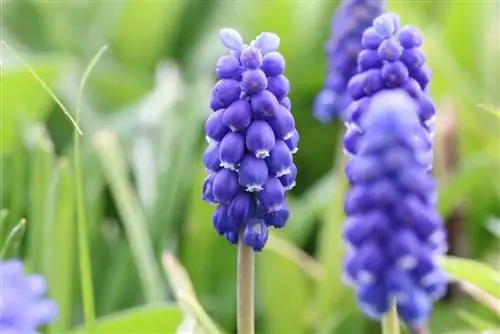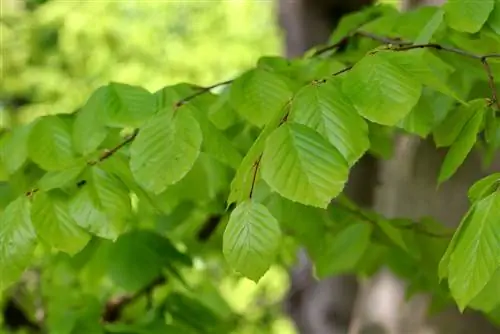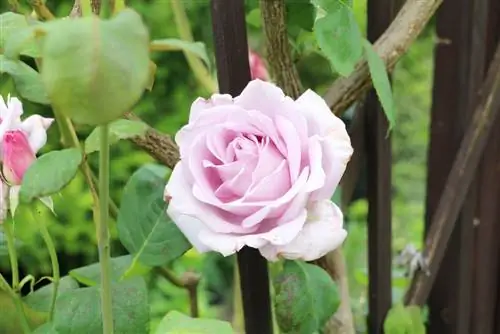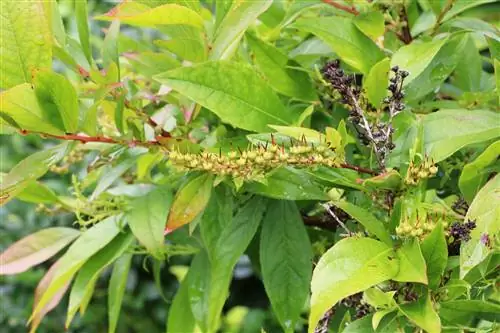- Author admin [email protected].
- Public 2023-12-17 03:39.
- Last modified 2025-06-01 06:48.
Grape hyacinth - planting and care instructions The grape hyacinth is considered one of the most beautiful flowers. Their mostly blue to purple flowers cover entire beds from the beginning of spring. The grape hyacinth owes its name to its flowers, which, when viewed up close, look like upside-down grapes. The plant belongs to the asparagus family and forms a bulb underground. The grape hyacinth is particularly striking due to its strong, unique smell. The grape hyacinth can reach a height of up to 40 centimeters.
Profile
Height 15 - 40 cm
Planting distance 7.5 -10 cm
Bloom from early spring to early summer
Well-draining soil
Full sun to partially shaded location
Onions available in autumn
The planting
The grape hyacinth can be planted in almost any soil. In addition to the classic bed, cultivation in pots and balcony boxes is also possible. It is a very robust plant that can be planted in many locations. A very bright location is most recommended. It is therefore best to choose a bed on which no shadow is cast. However, if the trees in the garden are thinner, the grape hyacinth can also be cultivated below such plants without any problems. The more the flowers are in the shade, the fewer flowers they will produce. The plant also does not place high demands on the properties of the soil:
- The selected soil in the bed should be permeable to water
- There should be no waterlogging if possible
- loamy and sandy soil is preferable
- Existing soil can also be loosened with additional sand
- the soil should be as loose as possible and not too heavy
- the soil must be pure in nutrients.
In general, grape hyacinths can be planted in almost any soil at any location. However, the better the conditions are for the plant, the more it rewards the gardener with a higher number of flowers and a higher reproduction rate. The planting process itself is also relatively easy with this uncomplicated plant:
- planted using small flower bulbs
- the ideal time is autumn
- a hole 8 to 10 centimeters deep should be dug in the ground
- The surface of the earth must then be carefully pressed down
- the distance between the individual specimens should be approx. 10 centimeters
- an arrangement in smaller groups is recommended for visual reasons
- Grape hyacinths look particularly good with tulips and daffodils.
Overall, cultivating the flower turns out to be particularly easy and can be achieved without much effort.
Proper care of grape hyacinth

The plant is also very uncomplicated and robust when it comes to care. You should make sure that the grape hyacinth is watered regularly and moderately and that the bulb never dries out completely. However, the water must also be able to seep through the soil easily, otherwise waterlogging can occur. In the worst case scenario, this leads to the formation of mold on the onion. In late summer, the leaves of the grape hyacinth dry out. From then on, the plant no longer needs to be watered. Fertilizing should then also be stopped. A few things should be taken into account when fertilizing grape hyacinths:
- Fertilization with a layer of compost in spring is particularly recommended
- Blühdinger is also well suited (highest possible phosphorus content)
- Use Blühdinger once before and once after the flowering period
- Stop fertilizing when the leaves fade
- don't use too much fertilizer.
The rapid multiplication
With a particularly favorable location and regular care, grape hyacinths multiply very quickly without the gardener's intervention and can take over entire gardens. That's why they are particularly suitable for making gardens wild. If rapid propagation is not desired, the leaves should be cut off generously when they begin to yellow. If you want to take care of the propagation of the plants yourself, you should also wait for the time when the plants begin to dry out and collect the seeds. These can then be sown at any location in spring or autumn. It is important to ensure that the soil is kept well moist when sowing. After several years, flowers begin to form. However, most gardeners propagate grape hyacinth via seed bulbs, which form on the mother bulb in summer. These must be dug up and planted in autumn. Plants cultivated in this way bloom for the first time in the following spring. Another alternative is to divide the onion individually. To do this, the grape hyacinth must first be dug up after flowering. The roots must not be damaged. These must then be carefully pulled apart. The individual lots must then be replanted immediately.
Wintering
Grape hyacinths have a bulb that can remain underground all year round because the flower bulb is frost-free. Each spring the plant will sprout again from the soil and begin to produce flowers. However, things look different if the grape hyacinth has not been cultivated in the garden bed but in pots or balcony boxes. The containers in question should be moved to a place that is frost-free and as dark as possible in the fall. The soil should be kept slightly moist at all times. Before the plant starts to sprout again, the container should be moved back to a bright location and the soil fertilized.
Typical diseases of grape hyacinth
The grape hyacinth is an extremely robust plant. It is only susceptible to a few diseases. The most common infestation is that of smut fungus. This is particularly common when the grape hyacinth is in a shady location, the soil is too moist and the individual plants are too close together. This smut mushroom is characterized by the following criteria:
- very many different types possible (approx. 1200)
- the flower heads of the grape hyacinth are particularly affected
- black or white spot formation
- Affected plant parts must be completely removed.
Popular species and varieties
Muscari armeniacum produces cob alt blue, white-edged flowers that appear until late spring and have a pleasant scent. Because it spreads quickly, this 20 - 25 cm high species is often cultivated.
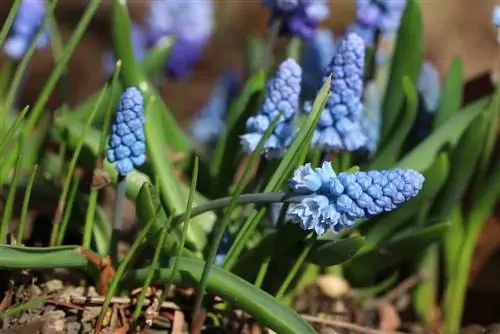
Muscari aucheri (syn. M. tubergenianum) produces both pale blue and dark blue flowers in a single cluster that appear at the beginning of spring.
Muscari botryoides `Album`bears white, also strongly aromatic flowers that appear in the second half of spring. This variety grows 15 - 25 cm high.
Muscari comosum blooms in olive green and purple. At the tip of the racemose inflorescence there is a tuft of sterile flowers. This grape hyacinth produces its flowers in late spring, which is later than all other Muscari species. At 40 cm high it is also quite large. Blue-violet cultivated forms are 'Plumosum' and 'Monstrosum'.
Culture
The flower bulbs are planted about 7.5 cm deep in autumn and arranged in groups. They thrive in any well-watered soil and can be grown in full sun locations as well as under light deciduous trees.
Conclusion
The grape hyacinth is a beautiful plant with very attractive and numerous flowers, which is a real splendor in spring. With a little care you have very little work to do with the grape hyacinth and can admire its rapid reproduction.

